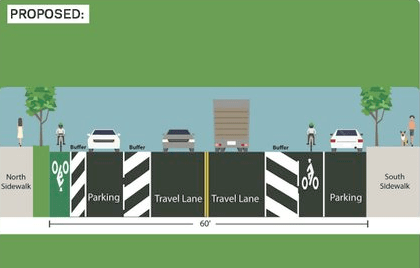The de Blasio administration says it will make what is apparently an unprecendented move during the so-called Vision Zero era: It will remove a protected bike lane from a major street that it had redesigned to save lives.
Bowing to political pressure from a Congressman who couldn't even get out of his car to assess a pair of lanes on Dyckman Street installed last year, DOT said in a late Friday tweet that it will eliminate the eastbound protected bike lane and retain the westbound one.
The move will endanger cyclists and create more room for illegal parking. Some residents and business owners had complained that they could no longer park — mostly illegally — after DOT installed the lanes on .3-miles of Dyckman between Broadway and Nagle Avenue last December [PDF]. Neighborhood cycling advocates had pushed for the design for almost a decade, but business owners claimed the bike lane made double-parking harder.

Manhattan Borough President Gale Brewer and U.S. Rep Adriano Espaillat were the most prominent voices opposing the plan, though sometime bike advocate Council Member Ydanis Rodriguez, also came out against it. Rodriguez called for a two-way protected bike lane on only one side of the street, a rare design that DOT typically uses when there is little cross-traffic, as along Prospect Park West or Kent Avenue.
Rodriguez told Streetsblog that he supported the removal of the eastbound protected lane. He deflected blame, saying he did the best he could to keep some protections for cyclists — nine of whom have died on city streets this year.
"There was a lot of pressure to remove any type of bike lane from Dyckman," Rodriguez said. "In that reality, I did my best as someone who believes that the street doesn't belong only to car owners but also belongs to pedestrians and cyclists to maintain the bike lane on that important corridor."

It's unheard of for DOT to remove a protected bike lane after it's already been installed — and it's bound to make the street less safe. Over 300 people were injured in crashes on Dyckman between 2009 and 2017. Post-bike lane data is not available yet, but protected bike lanes typically lead to significant safety gains.
The DOT claimed in its Twitter announcement — which came late on the last Friday of the summer, a classic ploy of government officials when they want to announce something but not draw too much attention — that the new design would be an "improvement."
#VisionZero safety improvements will begin on Dyckman St following resurfacing work (weather permitting):
— NYC DOT (@NYC_DOT) August 31, 2018
🚴♀️ Install parking protected #bikenyc lane on north side of Dyckman
🚗 Add curbside buffered parking lane on south side
🚶 Add painted pedestrian space pic.twitter.com/Kjo56JjEun
The real problem on Dyckman Street is below-market parking rates, which encourage drivers to crowd the street — whether or not they have a place to park. Instead of addressing that issue, the city is punishing cyclists.
"It is unfortunate that DOT is scapegoating safe space for bicyclists instead of addressing the real problem, which is non-enforcement of double-parking regulation," said Jonathan Rabinowitz, who was part of the group that pushed for bike lanes on Dyckman Street ten years ago.
DOT spokesperson Alana Morales attributed the changes to "extensive feedback from the community." She also cited complaints from the FDNY, though did not specify what those could be, given that DOT typically consults with the Fire Department before installing the lanes in the first place. And at a community meeting in May, the FDNY did not express concerns about the bike lanes.
An FDNY battalion chief blamed any problems on double-parked drivers.
A painted bike lane is not a bike lane. It’s a double parking zone that tells drivers they matter more than the safety of cyclists. This hostility towards cycling scares away a million would be riders (kids, parents, grandmas) who rightly fear the risk of the road. @GaleBrewerNYC pic.twitter.com/ckoduYyAd9
— Jeff Novich 🚴 (@jeffnovich) September 1, 2018
But Morales defended the changes.
"We feel these modifications will address concerns while maintaining safety for all users using typical design treatments seen elsewhere across the city," Morales said.
A call to City Hall was not returned. The move will no doubt be seen among cycling advocates as a watershed moment, given that Mayor de Blasio has bucked considerable heat from some communities and approved protections for cyclists, such as in Sunnyside, along Queens Boulevard and on 111th Street in Corona.






